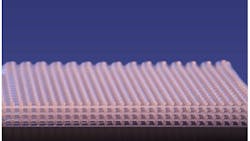3D Printing and Silicone Ink Lead to Energy-Absorbing Parts
Researchers at Livermore National Laboratory have developed a silicone-based “ink” that can be used in 3D printers to make cushions and pads. The energy-absorbing parts can have different levels of softness determined by how the 3D printer deposits the ink.
The ink cures to a rubberlike material. But during printing, the inkjet head deposits a pattern of horizontally aligned filaments of ink, and the filaments can be as fine as a human hair. The next layer is a pattern of vertically aligned filaments. This process repeats until the part has the preprogrammed height and pore structure. By altering the patterns, researchers adjust the part’s response to shear and compression, making them softer or stiffer.
“The ability to dial in a predetermined set of behaviors across a material at this resolution is unique, and it offers industry a level of customization never seen before,” says Eric Duoss, Livermore research engineer.
The new energy-absorbing material could replace gels and foams currently used for shoe and helmet inserts, vibration isolators, and protective materials for delicate equipment. The silicone-printed parts do not have the limitations of gels, which are relatively heavy and can be affected by temperatures; or foams, which have inconsistent performance due to the inability to control void size, shape, and placement when they’re manufactured.
